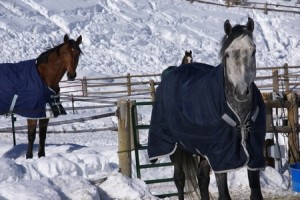If you decide you want to blanket your horse this winter, trying to choose the right horse blanket can be a bit overwhelming. There are so many factors to consider such as how to select the right size, what thickness or weight blanket your horse will need, and then of course you will need to decide what color and style to pick … it can be very challenging just trying to figure out where to begin! So here are a few tips and some information about blankets that will help you as you try to choose the right horse blanket.
How to Measure
Before you can start shopping for your new blanket, you will first need to know what size blanket your horse wears. First, get a flexible measuring tape and hold it next to your horse to make sure he’s comfortable around the tape and does not spook or act afraid of this new object. If you can find a crafter’s measuring tape, that would be ideal since it’s made of soft cloth and is also flexible. It’s also a good idea to have someone help you, so that one person can hold one end of the tape while the other person can accurately measure your horse. Take the measuring tape and hold one end of the tape right at the middle point of your horses’ chest and then slowly run the tape along the side of his body, coming all the way to the middle part of his tail. In order to get a precise measurement, you’ll need to make sure that you are running a straight line across the middle length of his body and that you are not holding the measuring tape too high up or down too low. The measurement that you get will be in inches and this is the size that you’ll need to use to choose the right horse blanket for a proper fit. If the measurement you get falls on a size that is not offered by blanket companies, then you can round the number up to the next size offered. Standard size blankets range from 64 inches for small ponies to 90 inches for large draft horses, so carefully measuring your horse is the key to selecting a well fitted blanket that will give him complete coverage. Generally speaking, an average size horse will most likely measure somewhere between 74 and 78.
Types of Horse Blankets
When doing your research on how to choose the right horse blanket, keep in mind that basically there are three types of blankets: Sheets, Stable Blankets and Turnout Blankets. The type of blanket that you select really depends on where you live, what your weather conditions are like, if your horse is stabled or lives in a pasture, etc. A lightweight sheet is ideal if you live in a warmer climate area and are looking for minimal protection, whereas if your horse lives outdoors where there is a lot of rain or snow, you will need a thicker weatherproof blanket for your horse. You might want to consider having a few different blanket options to choose from as your weather conditions change during the winter months.
Horse Sheets – Horse sheets are perfect lightweight coverage for your horse if you are looking for a blanket that will provide just a little extra warmth and you don’t really need something as heavy as a stable blanket. Horse sheets are also good to help prevent sun fading or to keep the dust off your horse, but because they are light weight they are usually more prone to tears or rips and may not hold up very well during turnout sessions.
Stable Blankets – Stable blankets are a good choice for horses that are housed in a stall or barn and are not directly exposed to winter elements such as icy cold wind, rain or snow. Stable blankets typically are not made of waterproof material, and can actually soak up the rain when wet which would make your horse even colder in the winter. If you keep your horse inside a barn or stall, then a stable blanket might be the best choice for your horse.
Turnout Blankets – Turnout blankets are usually made of thick, durable material and are designed for horses that are turned out or kept in a pasture and are outside in the winter elements. These blankets are generally made of heavy waterproof material that is breathable and designed to withstand the demands of tough horse play as well as cold, wet winter conditions.
Blankets are available in different weights, with light, medium and heavy being the most common choices. The blanket weight is based on the amount of insulation, also known as “fill”, which is the stuffing that is inside the blanket. As you are trying to choose the right horse blanket, it’s important to look at how much fill is in the blanket as this will determine how warm the blanket will be. The fill is usually made of either Polyfill or Fiberfill and is measured in grams; the higher the gram weight number is, the warmer the blanket should be. Light weight blankets have little or no fill, medium weight blankets have around 200 grams of fill and heavy weight blankets typically have more than 300 grams of fill.
The outer shell of the blanket also varies in strength and thickness depending on whether it’s a light weight cover up sheet or a heavy durable turnout blanket. Commonly referred to as “denier”, the strength of the blanket’s shell is determined by the thickness of the thread – the higher the denier number is, the stronger the blanket material will be. Denier strength starts at 210, which is considered to be very light strength, 420 is light strength and 600 is medium strength. Heavy to super heavy strength denier varies from 1200 all the way up to 2100, which would be suitable for extremely cold winter climates. When trying to choose the right horse blanket in terms of weight and thickness, you’ll also need to consider your horse’s age, if he grows a light or heavy coat, if he is clipped or not clipped, and if he’s kept inside in a stall or if he’s kept out in a pasture.
Styles and Fit
As you can imagine, horse blankets come in a wide variety of styles, materials and colors. Most standard blanket styles will fit from the shoulder to the tail and will cover your horse’s entire body, covering the withers, back, barrel and hindquarters. Some blankets have closed fronts and others have open fronts that allow your horse to move more easily in the pasture, and there will also be a strap around the girth area and rear leg straps to help keep the blanket in place. Some styles of blankets cover the tail area and form a “tent” while other blankets end right above the tail. Selecting a blanket style really depends on your personal preference and what best fits your horses’ lifestyle. Now here comes the best part of trying to choose the right horse blanket … selecting the color! Horse blankets come is all sorts of colors and shades – from solid colors to neutral toned plaids to wild fun animal prints … they even come in camo-green!
With winter right around the corner, you might also want to check out our blog on Winter Horse Care for Your Horse. Good luck with your winter horse blanket shopping and let us know what you select – we’d love to see pictures of your horse with his new blanket!







Deedee says
Trying to get a blanket for a big thick quarter horse measures 78″ but she’s short 14’2 hands like pony size all blankets seem to be way to long any ideas?